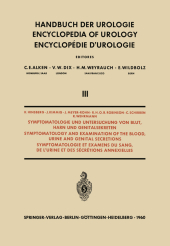 Neuerscheinungen 2012Stand: 2020-01-07 |
Schnellsuche
ISBN/Stichwort/Autor
|
Herderstraße 10
10625 Berlin
Tel.: 030 315 714 16
Fax 030 315 714 14
info@buchspektrum.de |

K. Hinsberg, J. Kimmig, J. Meyer-Rohn
(Beteiligte)
Symptomatologie und Untersuchung von Blut, Harn und Genitalsekreten / Symptomatology and Examination of the Blood, Urine
Softcover reprint of the original 1st ed. 1960. 2012. xvi, 338 S. XVI, 337 S. (30 S. in Englisch) 61 Ab
Verlag/Jahr: SPRINGER, BERLIN 2012
ISBN: 3-642-99868-2 (3642998682)
Neue ISBN: 978-3-642-99868-3 (9783642998683)
Preis und Lieferzeit: Bitte klicken
- Contents.- The significance of abnormality of the volume and of the composition of the urine.- A. Variations in the quality and quantity of the urine.- I. Abnormalities in the act of micturition.- 1. Frequency.- 2. Dysuria.- 3. Incontinence.- 4. Retention.- II. Abnormalities in the quantity of urine.- 1. Polyuria.- 2. Oliguria.- 3. Anuria.- III. Abnormalities in the composition of the urine.- 1. Proteinuria.- 2. Haematuria.- 3. Pyuria.- 4. Crystalluria.- a) Oxaluria.- b) Phosphaturia.- c) Uraturia.- d) Cystinuria.- 5. Chyluria.- 6. Bacteriuria.- 7. Pneumaturia.- B. Clinical examination of the urine.- I. Collection of specimens.- II. Physical characteristics.- 1. Quantity.- 2. Density.- 3. Colour.- 4. Appearance.- 5. Odour.- 6. Pneumaturia.- III. Chemical characteristics.- 1. Reaction.- 2. Constituents.- a) Normal inorganic constituents.- b) Normal nitrogenous or organic urinary constituents.- c) Abnormal constituents in the urine.- IV. Microscopic characteristics of the urine.- 1. Crystalline salts found in acid urine.- 2. Crystalline salts found in alkaline urine.- 3. Organic cellular deposits found on microscopical examination.- References.- Die Untersuchung des Urins.- Die Urininhaltstoffe, Vorkommen und Bildung.- A. Allgemeine Untersuchungen.- 1. Menge.- 2. Spezifisches Gewicht.- 3. Viscosität.- 4. Acidität (pH-Wert, Titrationsacidität).- 5. Optische Drehung.- 6. Geruch.- 7. Durchsichtigkeit.- 8. Farbe.- 9. Konservierung.- 10. Gefrierpunkt.- 11. Blutbeimengungen.- a) Hämoglobinnachweis.- ?) Hellersche Probe.- ?) Benzidin-Probe.- ?) Guajacoltest nach Stone und Burke.- b) Quantitative Hämoglobinbestimmung nach Flink und Watson.- 12. Zusammensetzung des Urins.- B. Die organischen Urinbestandteile.- 1. Vorkommen.- a) Die Eiweißkörper.- b) Essigeiweiß.- c) Bence-Jones-Eiweißkörper.- d) Albumosen und Peptone.- 2. Nachweis und Bestimmung der Eiweißkörper.- a) Qualitative Nachweismethoden.- ?) Essigsäure/Kochprobe.- ?) Modifizierte Kochprobe.- ?) Hellersche Ringprobe.- ?) Sulfosalicylsäureprobe.- ?) Ferrocyankaliumprobe.- ?) Biuretprobe.- ?) Millons-Probe.- ?) Xanthoproteinreaktion.- b) Quantitative Methoden.- ?) Quantitative Bestimmungen von Eiweiß nach Esbach.- ?) Gravimetrische Bestimmung von Eiweiß nach Scherrer-Bang.- ?) Colorimetrische Bestimmung von Eiweiß nach Hiller, Mcintosh und VanSlyke (Biuretmethode).- ?) Colorimetrische Bestimmung von Eiweiß mit dem Biuretreagens nach Forster, Rick und Wolfson.- ?) Colorimetrische Bestimmung von Eiweiß mit Amidoschwarz (C. H. v. Plumm, L. Hermansen und J. Petersen).- 3. Nachweis von Essigeiweiß.- 4. Nachweis und Bestimmung der Bence-Jones-Eiweißkörper.- a) Qualitativer Nachweis.- b) Quantitativer Nachweis nach Alder.- c) Nephelometrische Bestimmung der Bence-Jones-Eiweißkörper nach Engelfried.- 5. Qualitativer Nachweis der Albumosen.- 6. Die Aminosäuren.- a) Allgemeines.- b) Bestimmung der Gesamtaminosäuren.- ?) Formoltitration nach SöRensen.- ?) Titrimetrische Bestimmung nach VanSlyke, Mcfadyen und Hamilton.- c) Nachweis und Bestimmung einzelner Aminosäuren.- ?) Hippursäure.- ?) p-Aminohippursäure.- ?) Cystin.- ?) Bestimmung von Indican nach Larsson.- ?) Bestimmung von Histidin nach Schmidt.- 7. Harnstoff, Ammoniak und organische Basen.- a) Allgemeines.- b) Bestimmung von Harnstoff durch Diffusion.- ?) Bestimmung nach Conway.- ?) Gravimetrische Bestimmung von Harnstoff durch Fällung mit Xanthydrol nach Wenger und Mitarbeiter.- ?) Colorimetrische Bestimmung von Harnstoff nach Lee und Widdowsen.- ?) Colorimetrische Bestimmung von Harnstoff mit Diacetylglyoxim nach Wheatley.- ?) Bromlaugenmethode.- c) Bestimmung von Ammoniak.- ?) Bestimmung nach Folin.- ?) Permutitmethode zur Bestimmung von Ammoniak.- ?) Titrimetrische Bestimmung von Ammoniak mittels der Diffusionsmethode nach E. J. Conway und E. O´Malley.- d) Nachweis und Bestimmung von Kreatin und Kreatinin.- ?) Qualitativer Kreatininnachweis.- ?) Quantitative Bestimmung von Kreatinin und Kreatin.- e)


